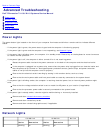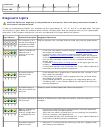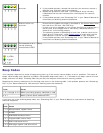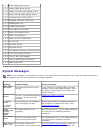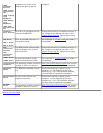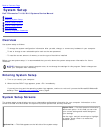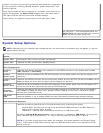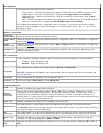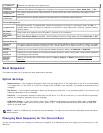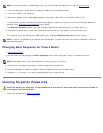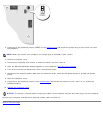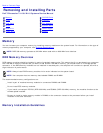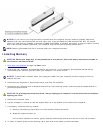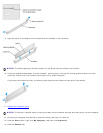
Boot Sequence
Lists the drives in the order by which they boot.
Floppy device - Identifies and defines the floppy drive attached to the FLOPPY connector on the
system board. If there is no installed drive, it appears as Floppy device (not installed).
Hard-Disk Drive - Identifies the hard drive. The drive is listed by its drive letter (such as Hard
Disk Drive C:).
IDE - Identifies and defines the optical drive attached to the IDE connector on the system board. If
there is no installed drive, it appears as IDE CD-ROM Device (not installed).
An included device displays with a checkmark next to its listing. To remove the device from the boot
sequence, use the spacebar to clear the checkmark. To change the boot order, use + or - to move the
listing up or down.
Memory Information
Installed
System Memory
Identifies and lists the amount of detected memory.
System Memory
Speed
Identifies and lists the speed of the detected memory in megahertz (MHz). For information on supported
memory see Memory
.
System
Channel Mode
Identifies and lists the installed memory as either Dual or Single channel. For information on supported
memory see Memory
.
AGP Aperture
Identifies and lists the amount of memory dedicated for graphics. The values vary depending on the
capacity of installed memory.
CPU Information
Hyperthreading
If your computer's processor supports Hyper-Threading, this section displays the following options:
Disabled - Hyper-Threading is Off.
Enabled - Hyper-Threading is On.
CPU Speed
Lists the options for setting the processor speed as Normal or Compatible.
NOTICE: Changing the CPU Speed is not recommended, this may shorten the life of the processor and
void the warranty.
Bus Speed
Lists the speed that the processor runs in megaherz (MHz).
Processor ID
Lists the processor Clock Speed, and L2 Cache Size.
Integrated Devices
Sound
Enables or disables the onboard audio controller.
Network
Interface
Controller
You can set the NIC to On (default), Off, or On w/ PXE. When the On w/ PXE setting is active
(available only for the future boot process), the computer prompts the user to press <Ctrl><Alt><b>.
Pressing this key combination displays a menu that allows you to select a method for booting from a
network server. If a boot routine is not available from the network server, the computer attempts to boot
from the next device in the boot sequence list.
Mouse Port
Enables or disables the onboard PS/2-compatible mouse controller.
USB Emulation
Set to On (default) so that USB devices will be detected and supported in the operating system.
The No Boot option restricts external access to drive data. Use this option to prohibit users from booting
the computer using an external USB device.
USB
Controller
Set to On (default) so that multiple USB devices can be connected to a system without compromising
data speed. When set to Off, all connected ports share a set data speed that is equivalent to one port.
Serial Port
#1
Identifies and defines the serial port settings. Auto, the default setting, automatically configures a
connector to a particular designation (COM1 or COM3).
Parallel Port
Mode
Identifies and defines the parallel port settings. You can set the parallel port to Off, AT, PS/2, EPP, or
ECP.




